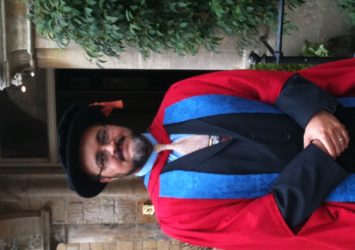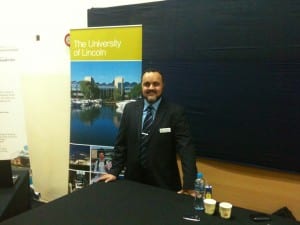 Dr Amr Ahmed, HoS of Computer Science (UNM), was invited as “Keynote Speaker” and “Guest of Honour” to the “International Conference on Advanced Computing Techniques and Applications (ICACTA 2020)” on 5th and 6th March 2020. The conference was held in Bangalore, India, and was organised and hosted by the Reva University. Amr initially delivered a short inaugural speech and then a full keynote speaker, which included an overview of research in the school of Computer Science (UNM). During the inaugural session, Amr was treated with the traditional “Mahraja” hat and robe, as in the photo, which is traditional in Bangalore, India. Amr had various discussions with the organisers and other guests who expressed interest in research collaboration.
Dr Amr Ahmed, HoS of Computer Science (UNM), was invited as “Keynote Speaker” and “Guest of Honour” to the “International Conference on Advanced Computing Techniques and Applications (ICACTA 2020)” on 5th and 6th March 2020. The conference was held in Bangalore, India, and was organised and hosted by the Reva University. Amr initially delivered a short inaugural speech and then a full keynote speaker, which included an overview of research in the school of Computer Science (UNM). During the inaugural session, Amr was treated with the traditional “Mahraja” hat and robe, as in the photo, which is traditional in Bangalore, India. Amr had various discussions with the organisers and other guests who expressed interest in research collaboration.
New Journal Paper – Accepted { Modeling Clinician Medical-knowledge in Terms of Med-level Features for Semantic Content-based Mammogram Retrieval.}
A new Journal paper accepted for publication in the ESWA journal: http://www.journals.elsevier.com/expert-systems-with-applications/:
Baâzaoui, A., Barhoumi, W., Ahmed, A. and Zagrouba, E. (2017). Modeling Clinician Medical-knowledge in Terms of Med-level Features for Semantic Content-based Mammogram Retrieval. Expert Systems with Applications. [Accepted for publication].
Based on the Journal Citation Reports 2016 (released in June 2017), the “Expert Systems with Applications” journal has an Impact Factor of 3.928
It also has a CiteScore 2016 of 4.70 with a CiteScore Percentile Rank of 98 (see details at https://www.scopus.com/sourceid/24201 )
Well done to the team….
PhD Studentship – “Object and Action Recognition”
Summary: “Object and Action Recognition Assisted by Computational Linguistics”.
The aim of this project is to investigate how computer vision methods such as object and
action recognition may be assisted by computational linguistic models, such as WordNet.
The main challenge of object and action recognition is the scalability of methods from
dealing with a dozen of categories (e.g. PASCAL VOC) to thousands of concepts (e.g.
ImageNet ILSVRC). This project is expected to contribute to the application of automated
visual content annotation and more widely to bridging the semantic gap between
computational approaches of vision and language.
Deadline: 20th March 2015.
A PhD studentship is advertised at
“Object and Action Recognition Assisted by Computational Linguistics”
The research is collaboration between University of Kingston (Digital Imaging Research Centre) and University of Lincoln (DCAPI group)
For details of the applications process: http://www.kingston.ac.uk/research/research-degrees/funding/phd-studentships-2015/faqs/
Deadline: 20th March 2015
New paper accepted in ICPR 2014 – “Compact Signature-based Compressed Video Matching Using Dominant Colour Profiles (DCP)”
The paper “Compact Signature-based Compressed Video Matching Using Dominant Colour Profiles (DCP)” has been accepted in the ICPR 2014 conference http://www.icpr2014.org/, and will be presented in August 2014, Stockholm, Sweden.
Abstract— This paper presents a technique for efficient and generic matching of compressed video shots, through compact signatures extracted directly without decompression. The compact signature is based on the Dominant Colour Profile (DCP); a sequence of dominant colours extracted and arranged as a sequence of spikes, in analogy to the human retinal representation of a scene. The proposed signature represents a given video shot with ~490 integer values, facilitating for real-time processing to retrieve a maximum set of matching videos. The technique is able to work directly on MPEG compressed videos, without full decompression, as it is utilizing the DC-image as a base for extracting colour features. The DC-image has a highly reduced size, while retaining most of visual aspects, and provides high performance compared to the full I-frame. The experiments and results on various standard datasets show the promising performance, both the accuracy and the efficient computation complexity, of the proposed technique.
Congratulations and well done for Saddam.
Analysis and experimentation results of using DC-image, and comparisons with full image (I-Frame), can be found in Video matching using DC-image and local features (http://eprints.lincoln.ac.uk/12680/)
Conference paper presented WCE’13 – 3rd July 2013 – London
The paper (titled “Video Matching Using DC-image and Local Features”) was presented by Saddam Bekhet (PhD Rsearcher) in the International Conference of Signal and Image Engineering (ICSIE’13), during the World Congress on Engineering 2013, in London UK.
Abstract:
This paper presents a suggested framework for video matching based on local features extracted from the DC-image of MPEG compressed videos, without decompression. The relevant arguments and supporting evidences are discussed for developing video similarity techniques that works directly on compressed videos, without decompression, and especially utilising small size images. Two experiments are carried to support the above. The first is comparing between the DC-image and I-frame, in terms of matching performance and the corresponding computation complexity. The second experiment compares between using local features and global features in video matching, especially in the compressed domain and with the small size images. The results confirmed that the use of DC-image, despite its highly reduced size, is promising as it produces at least similar (if not better) matching precision, compared to the full I-frame. Also, using SIFT, as a local feature, outperforms precision of most of the standard global features. On the other hand, its computation complexity is relatively higher, but it is still within the real-time margin. There are also various optimisations that can be done to improve this computation complexity.
Well done Saddam.
Conference paper Accepted to the “World Congress on Engineering”
New Conference paper accepted for publishing in “World Congress on Engineering 2013“.
The paper title is “Video Matching Using DC-image and Local Features ”
Abstract:
This paper presents a suggested framework for video matching based on local features extracted from the DC-image of MPEG compressed videos, without decompression. The relevant arguments and supporting evidences are discussed for developing video similarity techniques that works directly on compressed videos, without decompression, and especially utilising small size images. Two experiments are carried to support the above. The first is comparing between the DC-image and I-frame, in terms of matching performance and the corresponding computation complexity. The second experiment compares between using local features and global features in video matching, especially in the compressed domain and with the small size images. The results confirmed that the use of DC-image, despite its highly reduced size, is promising as it produces at least similar (if not better) matching precision, compared to the full I-frame. Also, using SIFT, as a local feature, outperforms precision of most of the standard global features. On the other hand, its computation complexity is relatively higher, but it is still within the real-time margin. There are also various optimisations that can be done to improve this computation complexity.
Gulf Education Exhibition/Visits in Oman
Dr Amr Ahmed attended the Gulf Education Mission and Exhibition (for International Students) in Muscat, Oman, as an Academic representative of the University of Lincoln, and the Lincoln School of Computer Science.
Morning: Visits to various International Schools
Evening: Education Exhibition, Raddison Hotel, Muscat, Oman.




